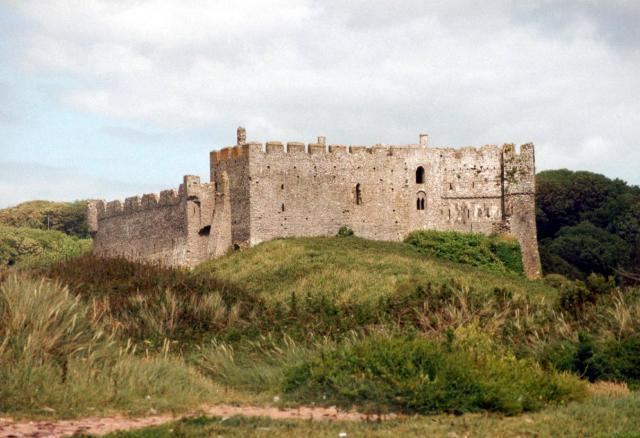Owner Private Condition Partially restored Phone +44 1834 870081 | Open tothe public Yes Built by William de Barri Built 12th century | |
 | ||
Height Up to 16 metres (52 ft) Hours Open today · 10AM–5PMMonday10AM–5PMTuesday10AM–5PMWednesday10AM–5PMThursday10AM–5PMFriday10AM–5PMSaturday10AM–5PMSunday10AM–5PM Similar Carew Castle, Llawhaden Castle, Pembroke Castle, Picton Castle, Caldey Island | ||
Manorbier Castle (Welsh: Castell Maenorbŷr) is a Norman castle located in the village of Manorbier, five miles south-west of Tenby, West Wales. It was the original seat of the Anglo-Norman de Barry family.
Contents
Construction
Manorbier is a rectangular enclosure castle, curtain walls, and round and square towers. Its tower gateway was protected by a great door and portcullis as well as roof embrasures. There was no moat as the castle stands on a natural promontory facing the coast. A postern gate provided access to the beach and boats.
There was an outer ward that was defended by earthworks but no barbican. The main gateway to the inner ward is across a bridge and dry moat. The south-east tower is round but the north-east one is angular. The domestic range of the castle had kitchens, apartments and a Great hall that was built in the 1140s. Arrowslits were replaced by windows in the domestic range.
The Chapel, which was built around 1260, has elaborate vaulting and plaster-work. Some of the original medieval frescoes can still be seen.
History
The castle was originally built on land granted to Odo de Barri, a Norman knight, at the end of the 11th century. Initially he constructed a Motte-and-bailey on the site which had a wooden keep defended by a palisade and earthworks embankments. But it was Odo's son, William de Barri, who began work on the stone fortification in the early part of the 12th century.
In 1146 Gerald of Wales, the great twelfth century scholar known as Geraldus Cambrensis was born at the castle. As the fourth son of William de Barri, he was related on his mothers's side, to the legendary Welsh princess Nest ferch Rhys. Gerald wrote of his birthplace:
In all the broad lands of Wales, Manorbier is the most pleasant place by far.
In the castle's history, it was only attacked twice; both were minor skirmishes. In 1327, Richard de Barri assaulted Manorbier in a dispute over family succession. Then 300 years later during the English Civil War, the castle was seized in 1645 by Parliamentarian forces. It was then slighted to prevent further use by the Royalists.
Through the 17th and 18th centuries Manorbier was allowed to decay. However, in 1880, the castle was partially restored by J.R.Cobb, a tenant who carried out repairs on the buildings and walls.
Present day
The castle is open to the public. Along with the castle, there are also gardens, dovecote and mill. The castle is very popular for wedding venues and has a holiday cottage which can be rented for wedding guests or private individuals wanting to stay in a castle.
Media appearances
The castle was used as Cair Paravel and The White Witch Castle by the BBC in an adaption of The Chronicles of Narnia.
The 2003 film I Capture the Castle was shot largely on location at the castle.
